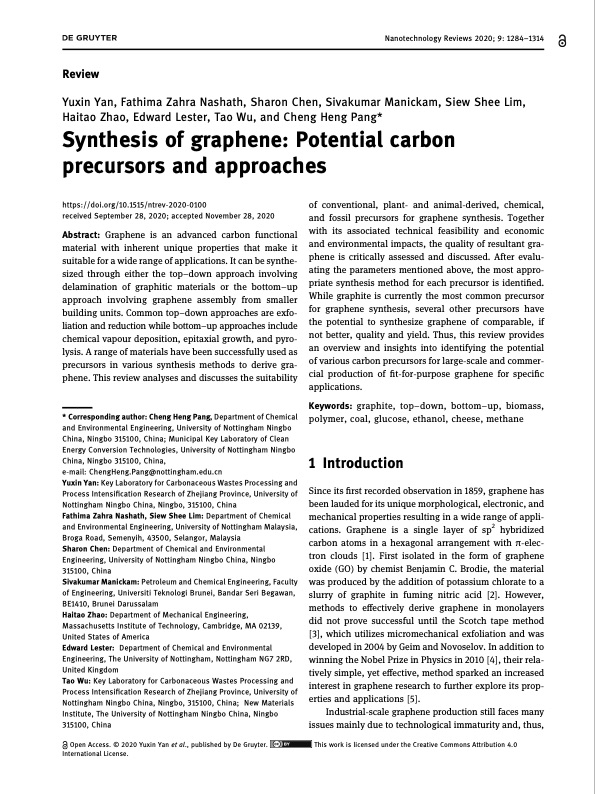
PDF Publication Title:
Text from PDF Page: 001
Review Yuxin Yan, Fathima Zahra Nashath, Sharon Chen, Sivakumar Manickam, Siew Shee Lim, Haitao Zhao, Edward Lester, Tao Wu, and Cheng Heng Pang* Synthesis of graphene: Potential carbon precursors and approaches https://doi.org/10.1515/ntrev-2020-0100 received September 28, 2020; accepted November 28, 2020 Abstract: Graphene is an advanced carbon functional material with inherent unique properties that make it suitable for a wide range of applications. It can be synthe- sized through either the top–down approach involving delamination of graphitic materials or the bottom–up approach involving graphene assembly from smaller building units. Common top–down approaches are exfo- liation and reduction while bottom–up approaches include chemical vapour deposition, epitaxial growth, and pyro- lysis. A range of materials have been successfully used as precursors in various synthesis methods to derive gra- phene. This review analyses and discusses the suitability * Corresponding author: Cheng Heng Pang, Department of Chemical and Environmental Engineering, University of Nottingham Ningbo China, Ningbo 315100, China; Municipal Key Laboratory of Clean Energy Conversion Technologies, University of Nottingham Ningbo China, Ningbo 315100, China, e-mail: ChengHeng.Pang@nottingham.edu.cn Yuxin Yan: Key Laboratory for Carbonaceous Wastes Processing and Process Intensification Research of Zhejiang Province, University of Nottingham Ningbo China, Ningbo, 315100, China Fathima Zahra Nashath, Siew Shee Lim: Department of Chemical and Environmental Engineering, University of Nottingham Malaysia, Broga Road, Semenyih, 43500, Selangor, Malaysia Sharon Chen: Department of Chemical and Environmental Engineering, University of Nottingham Ningbo China, Ningbo 315100, China Sivakumar Manickam: Petroleum and Chemical Engineering, Faculty of Engineering, Universiti Teknologi Brunei, Bandar Seri Begawan, BE1410, Brunei Darussalam Haitao Zhao: Department of Mechanical Engineering, Massachusetts Institute of Technology, Cambridge, MA 02139, United States of America Edward Lester: Department of Chemical and Environmental Engineering, The University of Nottingham, Nottingham NG7 2RD, United Kingdom Tao Wu: Key Laboratory for Carbonaceous Wastes Processing and Process Intensification Research of Zhejiang Province, University of Nottingham Ningbo China, Ningbo, 315100, China; New Materials Institute, The University of Nottingham Ningbo China, Ningbo 315100, China Open Access. © 2020 Yuxin Yan et al., published by De Gruyter. International License. of conventional, plant- and animal-derived, chemical, and fossil precursors for graphene synthesis. Together with its associated technical feasibility and economic and environmental impacts, the quality of resultant gra- phene is critically assessed and discussed. After evalu- ating the parameters mentioned above, the most appro- priate synthesis method for each precursor is identified. While graphite is currently the most common precursor for graphene synthesis, several other precursors have the potential to synthesize graphene of comparable, if not better, quality and yield. Thus, this review provides an overview and insights into identifying the potential of various carbon precursors for large-scale and commer- cial production of fit-for-purpose graphene for specific applications. Keywords: graphite, top–down, bottom–up, biomass, polymer, coal, glucose, ethanol, cheese, methane 1 Introduction Since its first recorded observation in 1859, graphene has been lauded for its unique morphological, electronic, and mechanical properties resulting in a wide range of appli- cations. Graphene is a single layer of sp2 hybridized carbon atoms in a hexagonal arrangement with π-elec- tron clouds [1]. First isolated in the form of graphene oxide (GO) by chemist Benjamin C. Brodie, the material was produced by the addition of potassium chlorate to a slurry of graphite in fuming nitric acid [2]. However, methods to effectively derive graphene in monolayers did not prove successful until the Scotch tape method [3], which utilizes micromechanical exfoliation and was developed in 2004 by Geim and Novoselov. In addition to winning the Nobel Prize in Physics in 2010 [4], their rela- tively simple, yet effective, method sparked an increased interest in graphene research to further explore its prop- erties and applications [5]. Industrial-scale graphene production still faces many issues mainly due to technological immaturity and, thus, This work is licensed under the Creative Commons Attribution 4.0 Nanotechnology Reviews 2020; 9: 1284–1314PDF Image | Synthesis of graphene Potential carbon precursors

PDF Search Title:
Synthesis of graphene Potential carbon precursorsOriginal File Name Searched:
10-1515-ntrev-2020-0100.pdfDIY PDF Search: Google It | Yahoo | Bing
Salgenx Redox Flow Battery Technology: Power up your energy storage game with Salgenx Salt Water Battery. With its advanced technology, the flow battery provides reliable, scalable, and sustainable energy storage for utility-scale projects. Upgrade to a Salgenx flow battery today and take control of your energy future.
| CONTACT TEL: 608-238-6001 Email: greg@infinityturbine.com | RSS | AMP |